It took about 3500 years for the 'Neolithic Package' to reach Andalucia from Anatolia in the Fertile Crescent. Was it a migration or something else?
By Nick Nutter | Updated 24 Aug 2022 | Andalucia | History |
Login to add to YOUR Favourites or Read Later
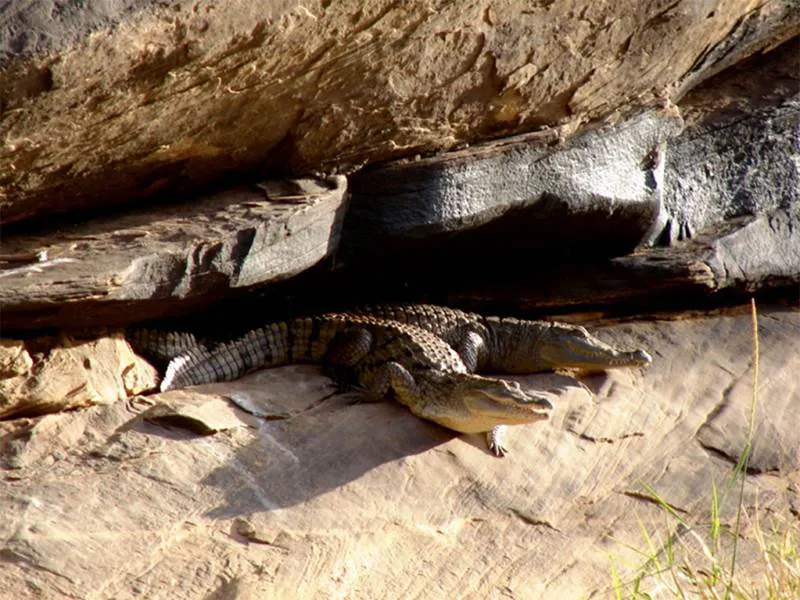
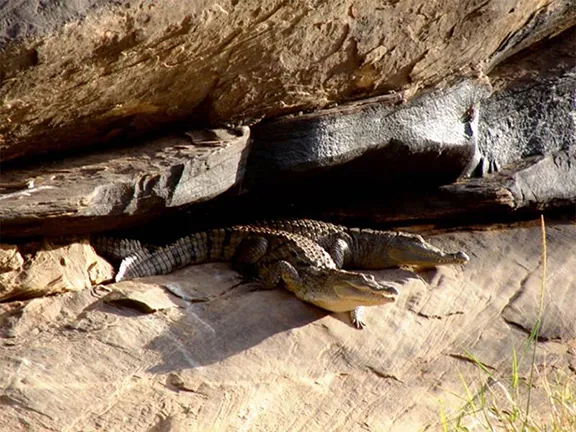
Desert Crocodiles in Mauretania
The dramatic effects of the oscillations and general improvement of the climate after the Younger Dryas (about 9500 BC) can be seen in the wider Mediterranean, which is where we now go to look at a development that would change the way of life of the whole of Europe. Whilst the human populations of Andalucia wobbled around a non-sustainable level, populations elsewhere were burgeoning to such an extent that they flowed over and out of the land they originally occupied.
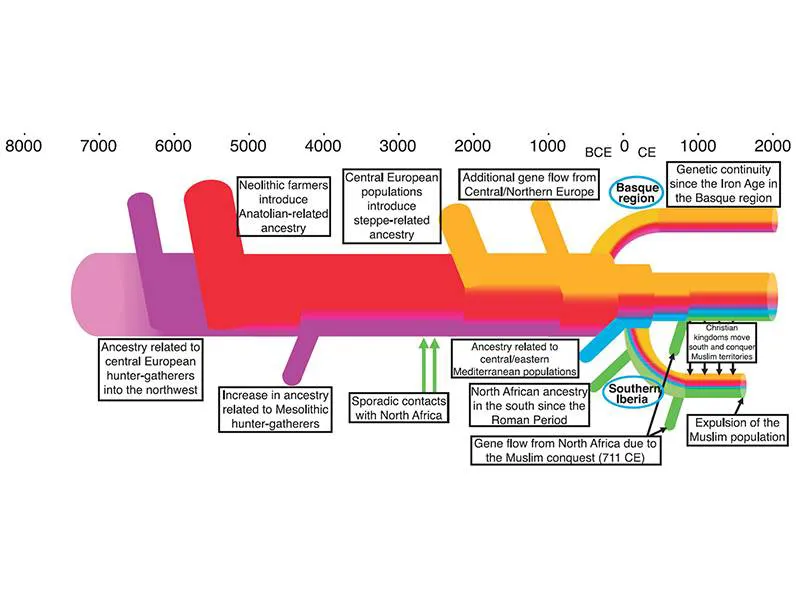
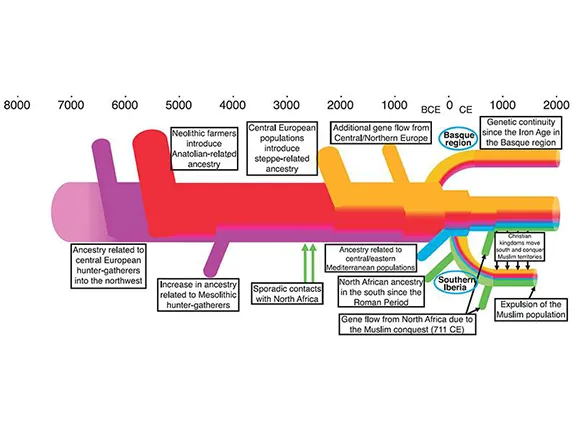
Gene Contribution to Iberians since 8000 BC
First a quick tour of the Mediterranean to look at what was afoot elsewhere. In the Levant, to which we will return shortly, rainfall increased to about 20% above current levels. More importantly the rains fell evenly throughout the year, raising water tables, bringing springs to life and feeding streams and rivers.
In the northern Mediterranean and temperate Europe, a chaotic succession of plants, trees and attendant animals eventually settled down in many areas to large tracts of mixed oak forest with conifers in the mountains and open scrub on the thinner, poorer, limestone soils. In the drier parts of the Aegean and, as we have seen, the Iberian Peninsula, tree cover was patchier. There were large areas of prickly scrub and tracts of savannah dotted with almond, pistachio and terebinth. In climatic enclaves the shrubs we consider typically Mediterranean, the woody, fragrant herbs, together with olives and other, evergreen, trees kept their heads down and survived.
In southern Anatolia and parts of the Levant, the woodland was, uncharacteristically, slow to advance, compared to areas at similar latitudes that were settled with a stable ecological system. This has been put down to humans burning the wood to clear the land for more productive use.
In North Africa, the changes were dramatic, and it is worth looking at in greater detail if only because it illustrates how quickly the environment can change. The summer monsoon shifted north some 600 – 700 kilometres. Rain fell on a parched Sahara creating large lakes, Lake Mega Chad was ten times the size of today, larger in area than Italy, and filling wadis that flowed into the Mediterranean. Shallow lakes and wadis covered a tenth of modern Lybia. Between the lakes was savannah, steppe and some remaining patches of semi or true desert. Elephants, giraffe, rhinoceros, buffalo and gazelle were quick to move in from the south whilst from the east, hippopotami and crocodiles moved from lake to stream to lake, or in the case of one group of enterprising Nile crocodiles, over the sand dunes.
In southern Mauretania a small group of these migrant crocodiles still survive. They are smaller than their cousins in the Nile, only a third their length. They live in areas where there is no permanent water, on the edge of the Sahara. The less it rains, the more they estivate (the reptilian version of hibernation). Whether true or not, the locals in this area believe they have a bond of trust with these sacred crocodiles that seems to extend to their domesticated animals who regularly drink from pools occupied by the crocs. When the pools dry out the crocodiles waddle back across the sand dunes to shaded rock shelters.
The rock art of the humans to arrive on the scene a little later recorded all these animals in vivid detail. By the time humans arrived in the Maghreb the incoming predatory beasts had seen off the resident giant buffalo, camel and deer.
A long belt of vegetation ran from the Nile, all the way to Morocco establishing a corridor for humans as well as crocodiles.
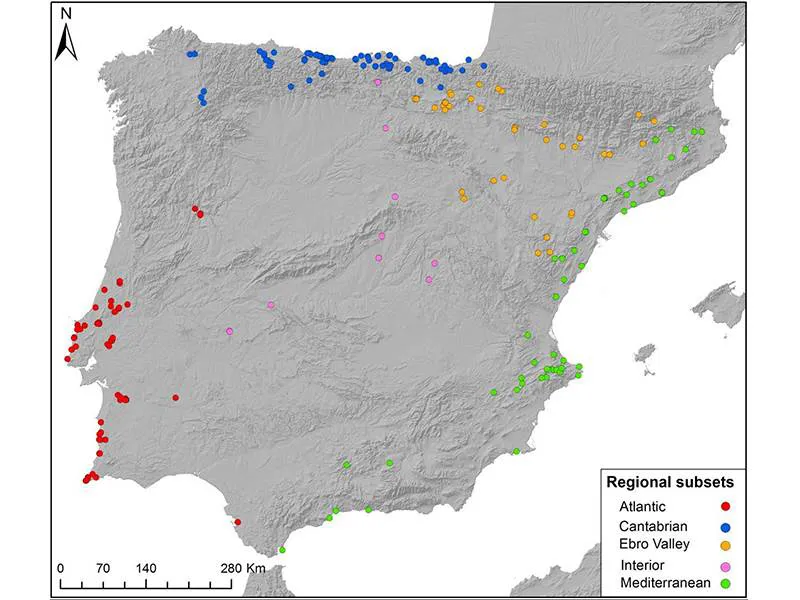
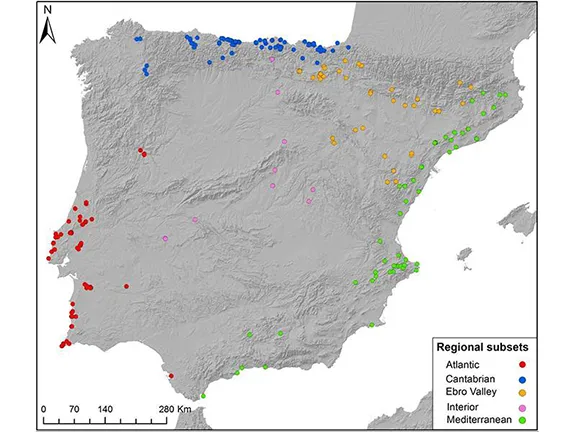
Last Hunter-Gatherer Sites in Iberia
We return to the Levant where the first farmers were building communities and transforming their society, culture, economy, relations between people and nature that would, as they spread, forever alter western Eurasia and parts of North Africa.
The Levant is the eastern Mediterranean area now covered by Israel, Lebanon, western Jordan and part of Syria. The Fertile Crescent extends from Egypt, through the Levant and then swings southeast, encompassing the Rivers Tigris and Euphrates down to the Persian Gulf.
Sometime during the Last Glacial Maximum, modern humans had started to grind, roast and bake wild cereals and pulses. Humanity had built up generations of knowledge and lore about plants and animals. They had even, in parts of the Fertile Crescent, during the Last Glacial Maximum, started to save wild seed to sow the following year. These people are known today as the Natufians.
The Fertile Crescent was also bountiful in its range of endemic plants, emmer wheat, einkorn wheat and barley, pea, lentil, chickpea and bitter vetch, all of which lend themselves to domestication by selective saving of seeds from plants that are producing larger or better crops.
The challenge with the cereals is to grow a plant that retains its head of grain for a short period after it is ripe to allow time for harvesting. Wild cereals produce heads in which the pods pop open to scatter the grain as soon as they are ripe. Early farmers circumvented this problem by cutting the grain just before it became ripe.
The range of herbivores living within the Crescent was also propitious. Of the 148 large herbivores on the planet, only a tenth have ever been domesticated. The remainder are too skittish, too aggressive, unwilling to breed in captivity or just plain behaviourally, intractable. The Fertile Crescent had four animals suitable for domestication, sheep, goats, boar, the ancestor of domesticated pigs, and the auroch, ancestor to domesticated cattle.
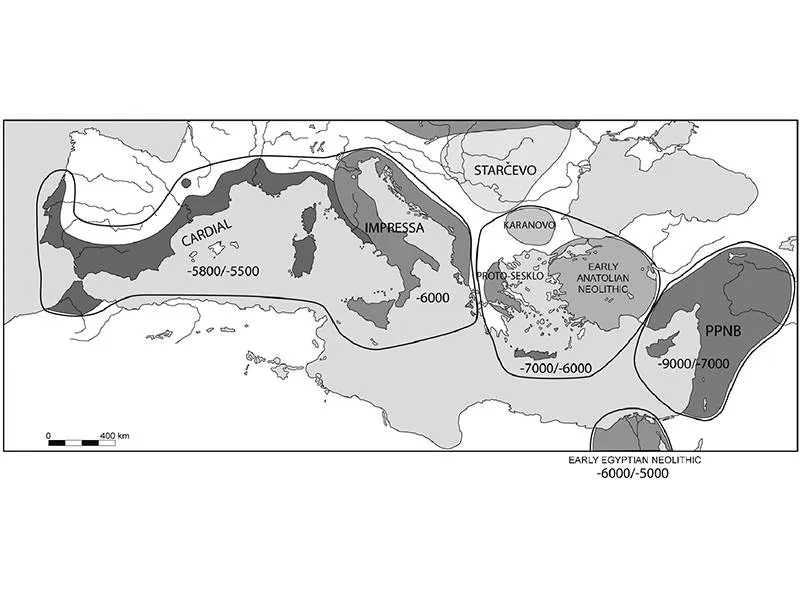
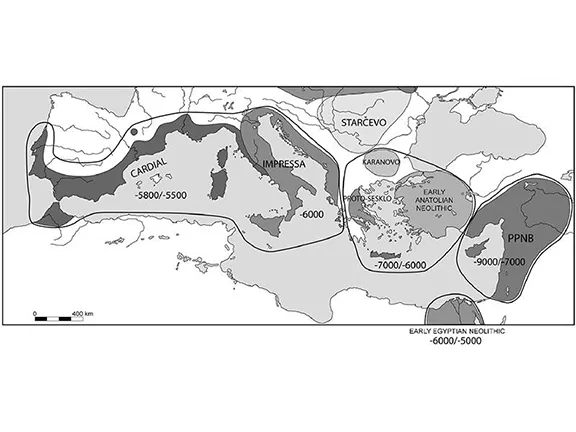
The Neolithic Expansion
The time was ripe for the next great step to be taken by mankind, albeit in short paces to begin with, the Neolithic.
As with plants, domestication of the animals took time. Sheep and goats are naturally herding animals and, whilst larger game had been readily available, were largely ignored by hunter-gatherers. As the larger game diminished, these smaller animals became more attractive. It was a short step from herding large numbers into ‘killing zones’, valleys laid out with walls and hurdles that allowed the incoming animals to be corralled and dispatched at leisure, to actually nurturing them.
The auroch was another matter. It was a hulking mass of bad tempered meat, long feared and held as sacred by ancient hunter-gatherers. Its domestication was probably more to do with symbolism than a desire for fillet steak. Since far back in the Pleistocene, cave art and figurines had deified this animal. Even into historical times, the descendant of those first aurochs, the bull, was revered and feared. The Minoans had a tradition of bull leaping, the Minotaur was a bull-headed monster that supposedly lived in a labyrinth below King Minos’s Palace on Crete. Bull leaping still goes on today in Spain, France and India. Certain religions in India revere cattle to such an extent that they cannot be slaughtered.
This irrational practice came about by people in the Indus valley realising that oxen were more valuable as draught animals to pull ploughs and for providing manure to fertilise their fields. Early religions took up on this, religious leaders only became wealthy if they could ‘tax’ their flock, take part of their crop for themselves and to enhance their status amongst their peers. Surplus crops also created non manual jobs for the early priests, somebody had to look after the stored grain and allocate it out for food and as seed for the following year’s crop. Oxen clearly made crop growing more efficient. The answer - deify the cattle.
Bull fighting, particularly in Andalucia, still has its supporters and its heroes, the matadors, fearless in front of the fighting bull.
The above are just a couple of examples of how some early Neolithic practices and beliefs have endured to this day, albeit in modified form. Perhaps we should not be that surprised, the length of time we are talking about is only 11,000 years, a mere blink of the eye compared to the length of time hunter-gatherers were around before the Neolithic.
All this did not happen overnight, or even in one place. One plant would be cultivated in one place, one in another. One animal would be gathered into herds in one area, another in yet another area. The requirements of the auroch and the sheep are very different so much depended on the land itself.
In all areas, farming was initially supportive of hunting, rather than a replacement and for a long time, if agriculture failed, the backstop move was to return to hunting and gathering. Farming developed different forms. Some pastoralists, in areas less well watered, found that their best option was to adopt a nomadic lifestyle and move around the landscape with their herds. Some cultivators majored on crops and used hunting to supply meat. The variety and choice was wide and each choice led to a society that had to learn different skills and adopt different attitudes to one another.
What happened in all cases, apart from when the ‘farming’ was purely pastoralism, in all parts of the world where farming developed independently, including China, the Indus valley and South America, is that people found it most efficient to bind themselves into communities, the first permanent settlements. They found that working together they could produce more food than the same number of individuals working alone. Populations grew. Surplus food was used to feed non-productive mouths. Artisans of all kinds, potters, weavers, tanners and others started to congregate in the settlements and exchange their products for food and shelter. People emerged to control the surplus and found they could grow rich (in produce) as a result. Those same people then found, on occasion, they had to fight to defend their surplus from neighbours who may have had a bad harvest, so they recruited followers. They paid them with food and shelter and rewarded them with control over land. The farmer had to grow more to pay his ‘taxes’ to the leader and whichever acolyte happened to control the land on which he farmed. Increased demand encouraged innovation and more efficient methods of producing more in less time. All this of course was sold to the peasant farmers as ‘a good thing’. They had food, a mechanism that protected them from poor yields, so long as the harvest was good the following year, a protector who had people prepared to fight for them and who now and again threw a big party, a feast. What more could they ask for? It was a machine that, once started, was impossible to stop.
By 8500 BC, Jericho was the largest city in the world at that time with a population of more than 500 people. It was the first settlement that could, if it so wished, genetically reproduce itself within its own boundaries.
But Jericho was not the only large settlement, there were others at Netiv, Hagdud and Gilgal in the Jordan valley and Tell Aswad near Damascus. Smaller settlements were scattered all along the Fertile Crescent solving different problems in different ways.
Signs of permanence started to appear. First in the materials used to make dwellings. Mudbricks were used to make circular huts. Between them were well built grain silos. As these collapsed, new ones were built on top of the debris creating a mound or tell, similar to the shell middens in Portugal, the ultimate ‘we have been here for ever’ signal to anybody that wanted to dispute the fact.
Ritual started to take on immense importance with ceremonies that drew people in and helped to resolve the problems created by the physical proximity of such a multitude in places like Jericho. A growing awareness of identity and individuality between families is indicated by the first painted, interior walls of dwellings.
Farming was not easy. It involved many more hours work per person than hunting and gathering. The work was also harder; hoeing, weeding, watering, sowing and reaping in a never-ending cycle. The rewards however were great. Five people could exist on just a few hectares of fields compared to the far greater area needed by a hunter-gatherer band. On the demerit side, the labour regime dominated everyday life, culture and ideology and prompted farmers to consider not just ownership of the fruits of their labours but hereditary rights over the land itself.
Farming also entrenched divisions of labour by gender. Plants had become the female domain during the hunter-gatherer period. This then extended to milling grain and cooking. There are signs that females tended the ‘kitchen garden’, plants grown in close proximity to the dwelling, thereby creating two environments. A home-based environment, dominated by women, and an outside the home environment where activities such as hunting, long range provisioning, exchange of products between settlements and presumably fighting, were the preserve of men.
We must be careful not to go too far when looking at the Natufian Neolithic because the Neolithic was soon to leave its homeland and it would develop in slightly different ways wherever it thence took root. The questions of how and why the Natufian people moved and expanded have never neen fully resolved . One reason they expanded could have been burgeoning populations reaching a stage where the land they occupied could no longer support the numbers. Once the area of land under cultivation reaches a certain size, where it is not practicable to walk from home to the furthest fields, work and return in the same day, then it is time to think about a move.
Similarly, if the area of land suitable for cultivation is used up and cannot support a larger population, regardless of its area, then a move is required. A variation of this is if the land is exhausted by repeated sowing. Land not allowed to rest or not fertilised can be made sterile in only a few years. It appears that knowledge of the benefits of fertilisation using animal manure were realised in different places at different times. The ideal is a rotation of land under cultivation, grazed by cattle, then sheep or goats followed by pigs and then returning to cultivation. Cattle, pigs, sheep and goats have different grazing requirements and together return all the nutrients lost by cultivation. The practise of rotating different types of crop on the same land, root crops, legumes, brassicas etc., interspersed with manuring or fertilisation was a set of knowledge not gained until well into historical times.
It is possible that the move became ritualistic, a rite of passage, where a group of young men and their wives were packaged off every generation to find pastures new. There are indications that a suitable location for a move would have been identified by exploratory parties long before the exodus.
The exodus started about 8800 BC. By 8400 BC, on the plateau in Anatolia, north of the Fertile Crescent, people at Asikli Hoyuk had domesticated crops and managed sheep and goats from a cluster of tightly packed, claustrophobic mass of houses. This may have been a response to the cold winters experienced on this high plateau. As well as being pioneers of farming, they were also early users of copper. Small, cold hammered, copper items have been found there.
The site of Cayonu in southeast Anatolia has yielded thousands of beads, pins and awls made from malachite or native copper dating from the 9th millennium BC. By 7000 BC the people from Cayonu were also exploiting lead rich galena. Sporadic objects and metal working knowledge spread back to the Jordan valley. The early farming pioneers in the east were as intimately aware of the value of networks as their long-lost Mesolithic cousins in the Iberian Peninsula.
Still in southeast Anatolia. Hunter-gatherer bands had established semi-permanent residence near a site called Gobekli Tepe. There, from about 9000 BC, the local hunter-gatherers built a monument consisting of over 200 stone pillars carved with symbols and depictions of mythical and living creatures. Each pillar is 6 metres high and weighs up to 10 tons. The pillars were arranged in circles, similar to Stonehenge, on a tell some 15 metres high and 300 metres in diameter. The site is thought to have been of religious significance rather than residential. It is mentioned here because it is a rare instance of a hunter-gatherer band having the time and resources to establish semi-permanent residences, only experienced in the Iberian Peninsula at the Muge shell midden sites and an almost unique example of hunter-gatherers building a megalithic monument. It also demonstrates one response that hunter-gatherer bands had to incursions of farmers. About 8000 BC, as the Neolithic people were moving into the area, the entire complex was deliberately buried. It must have lost its significance to the hunter-gatherer bands that built it or perhaps they obliterated any trace of their presence prior to moving on in advance of the Neolithic tide.
By the mid-7th millennium BC, farming had spread to southwest Anatolia. By 6100 BC, they too were utilising copper on a regular basis.
The Neolithic spread to copper rich Cyprus early, about 8000 BC. This had to be accomplished by boat from the Levantine coast, a not inconsiderable 100 kilometre hop considering the cargo. Those early farmers took with them cattle, sheep and goats and, accidentally, mice. Found in a human grave were the remains of a cat interred at the same time as the human. Of symbolic relevance or just a celebrated mouser, we shall never know. The answer as to how they managed to transport livestock in small boats must be that the cattle, sheep, goats and pigs were all just weaned and hobbled. No safety conscious Natufian would want to share a canoe with a hulking mass of beef or a skittish goat. Their excavated settlements, consisting of mudbrick wall roundhouses, contain domesticated cereals and pulses, none of which were native to the island. An early introduction to the island may be interpreted as a failed attempt to domesticate another species. Fallow deer were brought across from the mainland soon after the first sheep. They were soon to be found all over Cyprus, and were hunted for well over a thousand years. DNA studies on the bones of these long dead domesticates show that the Neolithic farmers on Cyprus were regularly resupplied with stock from the mainland. Farming and sailing where clearly not incompatible.
The sea offered no impediment to Neolithic expansion, unlike on land, where we see a reduction in pace at certain points where Mesolithic people had become well established. Anatolia held up progress for over a thousand years, until about 6500 BC, after which the advance took another 600 years to reach the Bosphorus. The area south of the Alps between Slovenia and Turin proved resistant to Neolithic ways for at least 600 years between 6000 BC and 5400 BC.
Meanwhile, enterprising seafaring farmers were island hopping across the Aegean Sea to Greece. By 6800 BC, Crete had been brought into the fold. Short hops across the Adriatic took the first farmers to southern Italy by 6000 BC. Sicily, Sardinia and Corsica plus all of Italy and France from Marseilles to the southern Alps, were Neolithised by 5600 BC.
One hundred years later, the first farmers arrived in the Iberian Peninsula in Catalonia. It is likely that the 500 kilometres between Provence in France and Catalonia was accomplished by land rather than sea and that those pioneers used the western Pyrenees gap. A style of pottery known as Cardium pottery or Cardial ware, decorated by pressing the shells of molluscs (Cardium edulis) into the clay, is distinctive enough in both Provence and the Catalonian coast to provide a link between the two areas.
Then a remarkable thing happened. The entire coastal area from Catalonia round to the Tagus estuary in Portugal: from Catalonia, to Valencia, Murcia and southern Andalucia in Spain, then the Algarve and the west coast of Alentejo in Portugal, a distance of over 1,700 kilometres, was colonised in only 200 years. At Mas d’Is near Alicante, these first horticulturalists built houses and a nearby ditched enclosure. They then spread inland to upland sites such as Cova de l’Or, 650 metres up in the hills behind Valencia, with their wheat, barley, sheep and goats.
How this was accomplished is still one of the most controversial subjects amongst pre-historians. At the moment there are three main theories.
The first is that the colonisation took place on land, by Neolithic people who had originated in the area of Anatolia many generations previously. This would have meant an advance of 210 kilometres per generation, taking a generation to be 25 years back in the Neolithic.
The second is that there was no colonisation at all, that Mesolithic people saw the advantages and rapidly adopted Neolithic ways, so the advance was a technological advance rather than a physical advance. This does not explain how domesticated animals, not native to the Iberian Peninsula, arrive within this short space of time. The response to this, amongst some historians, is that the Mesolithic people independently domesticated cereals and animals. Research has firmly ruled this out apart from in the case of pigs. Genetic research indicates that soon after the introduction of farming, people living in southern Europe substituted the eastern breed of pigs for locally domesticated boars. The descendants of those boars live on in Andalucia providing us with superb Serrano Jamon and in Italy, their version of domesticated wild boar, with just as distinguished an ancestry, produces Prosciutto.
The third theory is that the colonisation took place by our friends, the seafaring farmer, coast hopping from southern France. Incredibly they missed the Balearic Islands that were not occupied by humans until about 2300 BC. We have already seen that the Mediterranean coastal areas of the Iberian Peninsula, particularly the Andalucian coast, was sparsely populated by Mesolithic hunter-gatherers. If this was the main mode of expansion, and evidence is accruing that along the Mediterranean and Atlantic coasts of Andalucia this was, indeed, how the Neolithic spread, then some coastal sites must surely be underwater, the sea levels at this time were still minus 10 metres compared to today. It may even be that the hard-pressed Mesolithic people saw the Neolithic incomers as saviours, if not so much for food then at least for a new influx of breeding stock.
Whichever way, or combination of ways, the Neolithic way of life moved from the eastern Mediterranean to the Atlantic coast, the Neolithic people established a network along which ideas and materials moved. As was demonstrated on Cyprus one use of the network there was to resupply the island with domesticated animals.
The Mesolithic coastal dwellers had taken to the water on occasion to visit islands for the sole purpose of hunting the native fauna and in one instance, from about 10000 BC, to extract obsidian from the island of Melos that was taken by a chain of islands to Attica but these visits were sporadic. There is evidence from fish bones found in cave sites that some coastal dwelling Mesolithic people did venture out a short distance from shore in order to fish but at least in the western part of the Mediterranean and the Atlantic coast, the Mesolithic hunter-gatherer preferred to have his feet firmly planted on dry land.Unlike the almost exclusively land based networks established by the first hunter gatherers, the Neolithic networks were a combination of by sea and by land. For the first time, linked networks stretched out across the Mediterranean Basin from the Levant to the Atlantic. Although the network as a whole stretched from one end of the Mediterranean to the other, for thousands of years it was a patchwork of local networks and routes that were interlinked due to the constraints of the vessels that were used. Even so it had immediate benefits, locally. For instance, the Neolithic people island hopped, and, in the Tyrrhenian Sea, they found three sources of obsidian, on the small islands of Lipari, off the north coast of Sicily, Palmorala west of Naples and Pantalleria halfway between Sicily and Tunisia. Before the Neolithic wave had even reached the Iberian Peninsula, they had created a network that transported obsidian to North Africa, Italy and France near Montpellier.
Alongside the how of it, we must also look at the technicalities. Some argue that the Mesolithic people rapidly adopted Neolithic practices whilst others argue that an advancing wave of Neolithic immigrants swamped the hunter-gatherers, almost a repeat of the Neanderthal to modern human transition. Others maintain that Neolithic incomers planted themselves in depopulated areas so faced no opposition or resistance.
Such arguments are best resolved on a case to case basis. First, we will look at the overall evidence for where the Neolithic people came from that primarily comes from DNA research conducted in the 21st century.
DNA research over recent years shows that Europeans have, in addition to that small percentage of Neanderthal DNA, up to 15% of their DNA deriving from the Near East. Analysis further shows that population replacement was greater in the east than in the west and higher in the Mediterranean latitudes than further north. One subject of this research is a human female found in a cave burial site near Europa Point on Gibraltar. She was a female aged between 30 and 40 years, she had dark hair and dark eyes and she died about 5,400 BC. In addition, 10% of her genes were from the Mesolithic, hunter-gatherers whilst 90% of her genes were from Anatolia in modern Turkey.
In 2017, a landmark paper was published by Anna Szécsényi-Nagy et al of the Laboratory of Archaeogenetics in the Institute of Archaeology, Research Centre for the Humanities, Hungarian Academy of Sciences, Budapest, Hungary. They reported on the ancient mitochondrial DNA results of 213 new individuals, and 125 already published individuals, from the northeast, central, southeast and southwest regions, the largest archaeogenetic dataset from the Iberian Peninsula to date.
The results showed that there was a substantial influx of Neolithic immigrants into northeast Spain from southern France via the Pyrenees – Mediterranean gap. The further those groups expanded into the inner, central and southern parts of the Iberian Peninsula, the greater became the indigenous hunter-gatherer component of the DNA. On a genetic level the Neolithic of the centre of the Iberian Peninsula showed more connections with northeast and southeast regions of the Iberian Peninsula. The paper also borrowed from previous, recent, genomic studies that showed that, after the initial Neolithic influx through the southern part of the Iberian Peninsula, there was an increase in hunter-gatherer genes in populations in central parts of the Peninsula. In addition, generally, the greater the distance from the Mediterranean coast, the greater the hunter-gatherer component.
Current research would indicate that, for the Neolithic people on the ground, or in boats for that matter, they found their progress through the Iberian Peninsula, down the Mediterranean coast, unimpeded due to the lack of hunter-gatherer bands. As they moved inland from their beachheads, they met increasing numbers of hunter-gatherers. The genetic mixing would indicate that both males and females, females in particular, were absorbed into expanding Neolithic bands with greater frequency the further into the Iberian Peninsula the Neolithic people penetrated, probably a reflection of the greater density of hunter-gatherer people, rather than speed of advance.
During the 1970’s, archaeologists introduced the term, ‘Neolithic Package’ into the lexicon. The Neolithic package covers a whole series of technical innovations that accompany the domestication of plants and animals, like ceramics and polished stone, changes in dynamics of territorial occupation and exploitation, organisation of domestic areas and forms of social production, social dynamics and reproduction. Settlements are variable depending on the geographical area, but they generally consist of traits signalling a more permanent occupation compared to foragers, such as domestic areas that include houses, grain storage, graves, hearths, and ovens. Tools and materials suggest that settlements are also areas of production and consumption. The Neolithic people probably had a far different concept of nature in terms of their relationship with the supernatural, plants, animals and the land, than the Mesolithic people. The likely animistic spirit worlds of the Mesolithic were replaced with the Neolithic obsession with ancestors and fertility, almost immediately in the new Neolithic settlements and over many generations as Mesolithic people became absorbed into the Neolithic world.
Contents of the full Neolithic package that evolved between 10000 BC and 6000 BC
Plants: emmer wheat, einkorn wheat and barley, pea, lentil, chickpea and bitter vetch
Domesticated animals: sheep, goat, pig, cattle
Ornament: animal, female and male figurines, marble or stone bracelets, beads, imported shells, phallus of bone, antler or clay
Utilities: stone bowls, bone ‘belt hooks’, bone spatulae, grooved stones, polished stone axe heads, ‘stamp seals’, bone polishers, ‘offering tables’, ‘ear plugs’, sling missiles, painted pottery
Domesticated dogs
However, not all places enjoyed the entire package at the same time as we shall see. And the presence of a few elements should never imply the presence of them all.
The Neolithic package should also include the knowledge carried and transmitted by the Neolithic people, including knowledge garnered on their journey that fed into the overall network.
A concept of life that involved more permanent settlement, the accumulation of possessions and associated ideas of ownership and identity, hard work, long hours, increasing family size and ideas of fertility, the beginnings of defined roles based on sex, not yet discrimination, and the spiritualisation of ancestors.
Cherry, John & Leppard, Thomas. (2018). The Balearic Paradox: Why Were the Islands Colonized So Late? La paradoja balear: ¿por qué las islas fueron colonizadas tan tarde?. Pyrenae. 49. 49-70. 10.1344/Pyrenae2018.vol49num1.2.
Cilingiroglu, Ciler. (2005). The concept of 'Neolithic package': Considering its meaning and applicability. Documenta Praehistorica. 32. 1-13. 10.4312/dp.32.1.
Fernández-López de Pablo, Javier & Puche, Magdalena. (2009). Climate change and population dynamics during the Late Mesolithic and the Neolithic transition in Iberia. Documenta Praehistorica. 36. 67-96. 10.4312/dp.36.4.
Martín Socas, Dimas & Massieu, María & Caro, José & Rodríguez-Santos, F.. (2017). The beginning of the Neolithic in Andalusia. Quaternary International. 10.1016/j.quaint.2017.06.057.
Olalde, Iñigo & Mallick, Subhashis & Patterson, Nick & Rohland, Nadin & Villalba-Mouco, Vanessa & Silva, Marina & Dulias, Katharina & Edwards, Ceiridwen & Gandini, Francesca & Pala, Maria & Soares, Pedro & Ferrando-Bernal, Manuel & Adamski, Nicole & Broomandkhoshbacht, Nasreen & Cheronet, Olivia & Culleton, Brendan & Fernandes, Daniel & Lawson, Ann & Mah, Matthew. (2019). The genomic history of the Iberian Peninsula over the past 8000 years. Science. 363. 1230-1234. 10.1126/science.aav4040.
Ollivier, Morgane & Tresset, Anne & Frantz, Laurent & Bréhard, Stéphanie & Balasescu, Adrian & Mashkour, Marjan & Boroneant, Adina & Pionnier-Capitan, Maud & Lebrasseur, Ophélie & Arbogast, Rose-Marie & Bartosiewicz, László & Debue, karine & Rabinovich, Rivka & Sablin, Mikhail & Larson, Greger & Hänni, Catherine & Hitte, Christophe & Vigne, Jean-Denis. (2018). Dogs accompanied humans during the Neolithic expansion into Europe. Biology letters. 14. 10.1098/rsbl.2018.0286.
Peltenburg, Edgar & Colledge, Sue & Croft, Paul & Jackson, Adam & Mccartney, Carole & Murray, Mary. (2001). Neolithic Dispersals from the Levantine Corridor: a Mediterranean Perspective. Peltenburg, E. and Colledge, S. and Croft, P. and Jackson, A. and McCartney, C. and Anne Murray, M. (2001) Neolithic dispersals from the Levantine Corridor: a Mediterranean perspective. Levant, 33 . pp. 35-64. ISSN 00758914. 33. 10.1179/007589101790217300.
Prieto-Martínez, M.. (2009). From Galicia to the Iberian Peninsula: Neolithic ceramics and traditions.
Sánchez, Miguel & Jiménez-Espejo, Francisco & Simón-Vallejo, Maria & Gibaja, Juan & Carvalho, António & Martínez, F. & Rodrigo-Gámiz, Marta & Flores, JA & López-Sáez, José Antonio & Peña-Chocarro, Leonor & Carrión, José & Morales-Muñiz, Arturo & Roselló, E & Riquelme, J.A. & Dean, Rebecca & Salgueiro, Emília & Sánchez, Rafael M & de la Rubia de Gracia, Juan & Bicho, Nuno. (2012). The Mesolithic–Neolithic transition in southern Iberia. Quaternary Research. 77. 221-234. 10.1016/j.yqres.2011.12.003.
Szécsényi-Nagy, Anna & Roth, Christina & Brandt, Guido & Rihuete, Cristina & Tejedor, Cristina & Held, Petra & García-Martínez-De-Lagrán, Íñigo & Arcusa Magallón, Héctor & Zesch, Stephanie & Knipper, Corina & Bánffy, Eszter & Friederich, Susanne & Meller, Harald & Ramírez, Primitiva & Bermejo, Rosa & De Balbin-Behrmann, Rodrigo & Herrero-Corral, Ana Mercedes & Flores Fernández, Raúl & Fernández, Carmen & Alt, Kurt. (2017). The maternal genetic make-up of the Iberian Peninsula between the Neolithic and the Early Bronze Age. Scientific Reports. 7. 10.1038/s41598-017-15480-9.
To read the full pdf with all images and maps click here